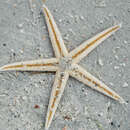Comprehensive Description
provided by Smithsonian Contributions to Zoology
Luidia clathrata (Say)
Asterias clathrata Say, 1825:142.
Luidia clathrata.–Lutken, 1859:37–39.–Gray, 1866:4.–Verrill, 1867:343; 1895:134; 1901:36; 1914:7, 31, pl. 103; 1915:200, pl. 24: fig. 2.–A. Agassiz, 1877:116, 117–119, pl. 20.–Perrier, 1878:34, 91, 95, 96.–Sladen, 1889:253, 742.–H. L. Clark, 1898a:5; 1901, p. 339, 343; 1919:54, 55, 71; 1933:19–20.–Doderlein and Hartmeyer, 1910:150–151.–Doderlein, 1920: 238, 239, 251–252, figs. 1, 21.–A. H. Clark, 1939:442.–Caso, 1943:46–50, pl. 12: figs. 1–2, pl. 13: figs. 1–2; 1961:39–41.–Bernasconi, 1943:6–7, pl. 2: fig. 1.–Tommasi, 1958:9, pl. 2: fig. 1; 1970:8, fig. 22.–Cherbonnier, 1959:170.–Durand, 1959:21–23, pl. 3.–Engel and Schroevers, 1960:5.–Ummels, 1963:95–97, pls. 10–11.–Gray, Downey, and Cerame-Vivas, 1968:139, fig. 8.
There are five arms, and the skeleton is compact. The paxillae are square, in regular longitudinal and transverse rows except on the midregion of the arms and disc. The center of the paxillae is covered with granules, the periphery with fine spinules. The broad midregions of the arms and disc have small irregularly shaped and arranged paxillae. The inferomarginal plates bear one moderately long, curved, flattened marginal spine and one or two small spines above it, not appressed to the arm. Below, there is a covering of very short spines and spinules. The adambulacral plates have two furrow spines, one behind the other, laterally flattened and somewhat curved, the inner spine more slender than the outer one. Behind these are two spines, side by side, flattened in the plane of the furrow. A few actinal interradial plates are present, one series extending a short distance on the arm. The oral spines form a thick cluster, and the jaws are covered with fine spinules. No pedicellariae were noted. The madreporite is concealed by paxillae.
Specimens in this collection are from 0–45 fathoms, from Cape Hatteras to northeastern South America and from the Gulf of Mexico. The known range is from New Jersey to Brazil. The color is usually light gray, with a darker gray stripe down the middle of the arm; however, specimens from the southern part of the range may be pastel. Also, the arms have a broader base; there are usually two or even three marginal spines, and an extra pair of side-by-side adambulacral spines may occur, especially proximally. These are not specific differences but geographic variations, of less than subspecific importance.
MATERIAL EXAMINED.–Oregon Stations: 1865 (1) [R=100 mm, r=12 mm, Rr=1:10]; 6300 (5) [R=77 mm, r=12.5 mm, Rr=1:7]; 3555 (1) [R=20 mm, r=6 mm, Rr=1:4]; 2272 (1) [R=54 mm, r=9 mm, Rr=1:5]; 2207 (1) [R=42 mm, r=9 mm, Rr=1:4]; 5894 (1) [R=67 mm, r=9 mm, Rr=1:6]; Silver Bay Stations: 1515 (1) [R=24 mm, r=6 mm, Rr=1:4]; 35 (1) [R=90 mm, r=11 mm, Rr=1:9]; 1952 (1) [R=120 mm, r=6 mm, Rr=1:20].
- bibliographic citation
- Downey, Maureen E. 1973. "Starfishes from the Caribbean and the Gulf of Mexico." Smithsonian Contributions to Zoology. 1-158. https://doi.org/10.5479/si.00810282.126

